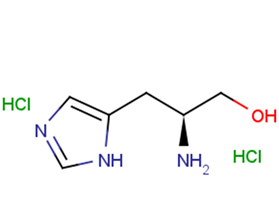
L-Histidinol dihydrochloride
CAS No. 1596-64-1
L-Histidinol dihydrochloride( —— )
Catalog No. M19736 CAS No. 1596-64-1
L-Histidinol dihydrochloride is a precursor of histamine and a reversible inhibitor of protein synthesis.
Purity : >98% (HPLC)
 COA
COA
 Datasheet
Datasheet
 HNMR
HNMR
 HPLC
HPLC
 MSDS
MSDS
 Handing Instructions
Handing Instructions
| Size | Price / USD | Stock | Quantity |
| 100MG | 37 | In Stock |


|
| 200MG | Get Quote | In Stock |


|
| 500MG | Get Quote | In Stock |


|
| 1G | Get Quote | In Stock |


|
Biological Information
-
Product NameL-Histidinol dihydrochloride
-
NoteResearch use only, not for human use.
-
Brief DescriptionL-Histidinol dihydrochloride is a precursor of histamine and a reversible inhibitor of protein synthesis.
-
DescriptionL-Histidinol dihydrochloride is a precursor of histamine and a reversible inhibitor of protein synthesis.
-
In Vitro——
-
In Vivo——
-
Synonyms——
-
PathwayProteasome/Ubiquitin
-
TargetEndogenous Metabolite
-
RecptorHuman Endogenous Metabolite
-
Research Area——
-
Indication——
Chemical Information
-
CAS Number1596-64-1
-
Formula Weight214.09
-
Molecular FormulaC6H13Cl2N3O
-
Purity>98% (HPLC)
-
SolubilityDMSO:10 mM
-
SMILESCl.Cl.N[C@H](CO)Cc1cnc[nH]1
-
Chemical Name——
Shipping & Storage Information
-
Storage(-20℃)
-
ShippingWith Ice Pack
-
Stability≥ 2 years
Reference
1.Inhibition of protein synthesis and heat protection: Histidinol-resistant mutant cell lines[J]. Journal of Cellular Physiology 1991 149(3):396-402.
molnova catalog



related products
-
Creatine D3 hydrate
Creatine D3 hydrate is a deuterium labeled Creatine hydrate. Creatine hydrate is pivotal in energy metabolism of muscle and brain cells, both in physiological and in pathological conditions.
-
5,6-Dihydrouridine
5,6-Dihydrouridine, a modified base, is located in conserved positions within the D-loop of tRNA in Eukaryota, Bacteria, and some Archaea.
-
(S)-3-Hydroxybutanoi...
(S)-3-Hydroxybutyric acid is a normal human metabolite that has been found elevated in geriatric patients remitting from depression.



 Cart
Cart
 sales@molnova.com
sales@molnova.com


